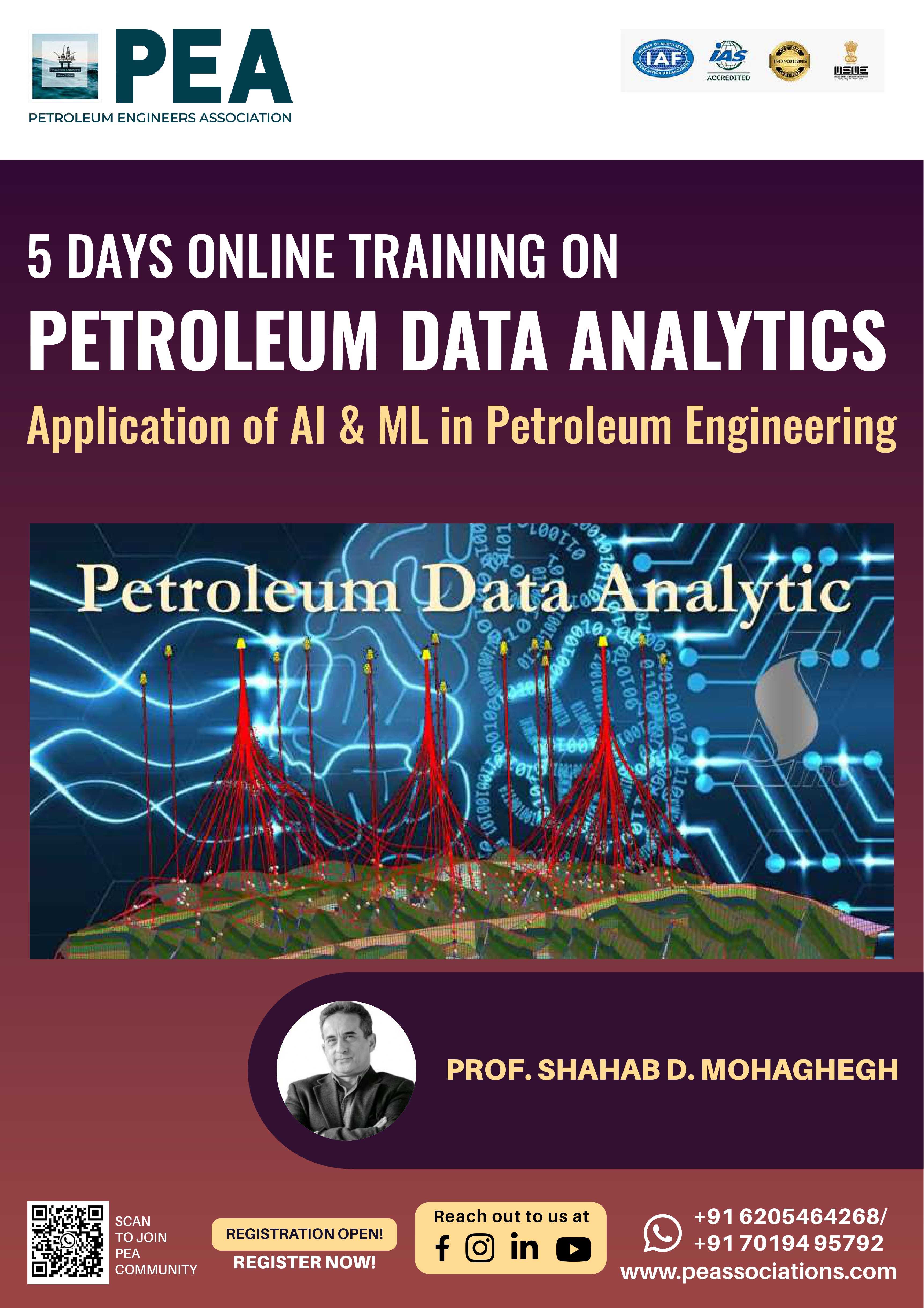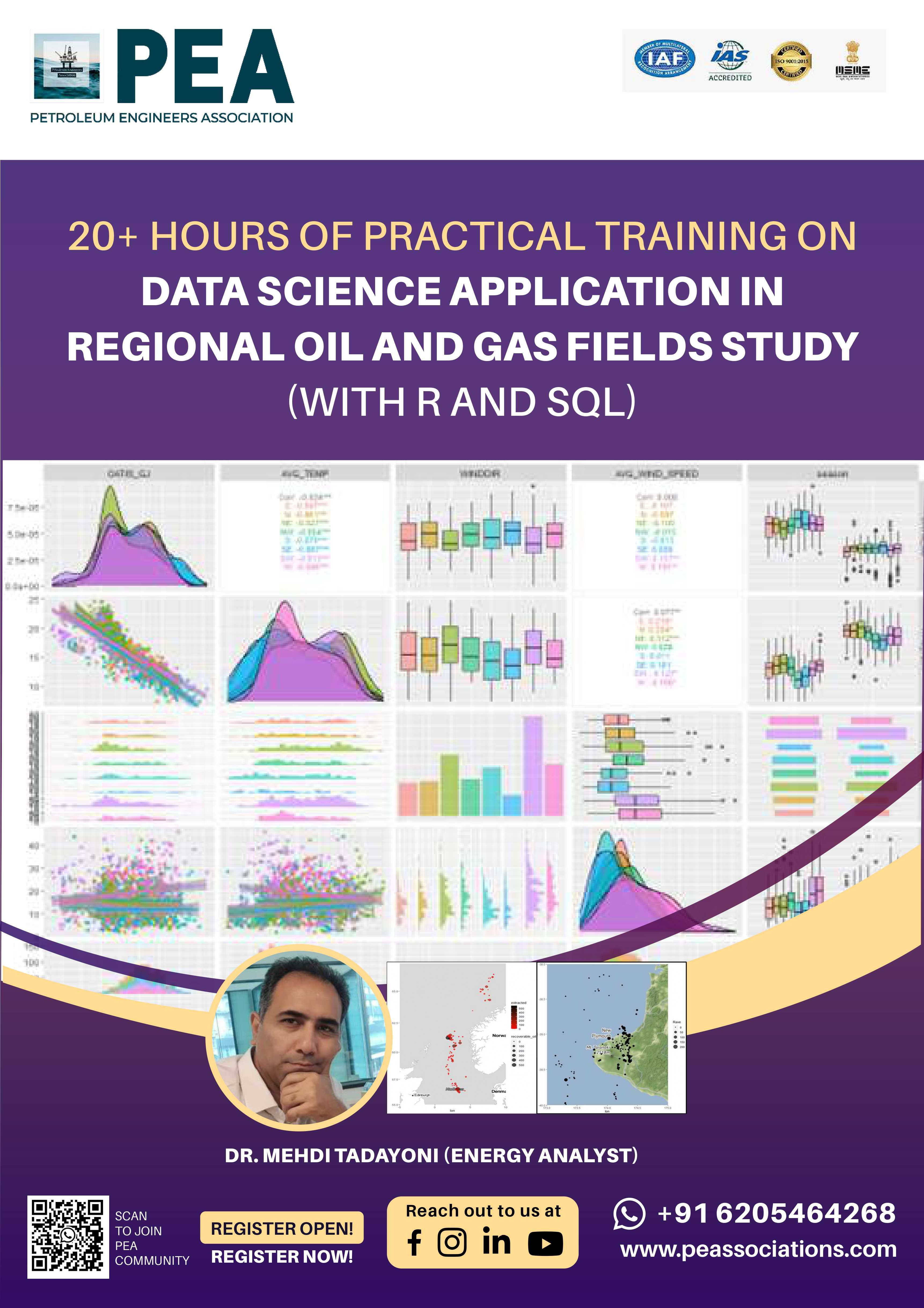Boost your team's skills and your budget! Enjoy group discounts for collaborative learning. Send an inquiry to info@peassociations.com.
Data Mining for Oil and Gas Professionals
The Data Mining Training equips professionals in the oil and gas industry with practical skills to extract valuable insights from large datasets. Participants will learn the full data mining process, including data preparation, exploration, association rule mining, and predictive modeling using Python. The training includes hands-on exercises and industry-relevant case studies to apply techniques for predictive maintenance, process optimization, and safety improvements. By the end, attendees will be able to turn raw data into strategic knowledge, driving informed decisions and operational efficiency.
Description
As data continues to play a crucial role in the oil and gas industry, professionals must stay equipped with the latest tools and techniques to harness its power effectively. This course dives into the essentials of data mining, offering practical, hands-on guidance in transforming raw data into actionable insights. Participants will learn how to identify patterns, uncover trends, and support decision-making, all while focusing on real-world applications in oil and gas.
The oil and gas sector generates massive volumes of data daily. Data mining skills allow professionals to turn this data into a powerful asset, supporting everything from resource management to predictive maintenance. In this comprehensive course, participants will gain an understanding of the methods and tools essential for extracting meaningful patterns from data to improve operational efficiency and make data-informed decisions.
The course combines interactive lectures, case studies, hands-on exercises, and group discussions, allowing participants to learn both theoretical concepts and practical applications. Real-world oil and gas scenarios are included to enhance relevance and ensure applicability.
Reservoir Engineers.
Production engineers.
Chemical engineers.
Drilling engineers.
Geologists and petrophysics
AL and workover engineers.
Any one with exposure to Large Volumes of Data
Module 1
A gentle introduction to Python Programming Language
Data types and Structures in Python
Introduction to Data Visualization
Working with Tabulated Data using Pandas
Basics of Data Cleaning and Transformation using Pandas.
Creating Calculations and Data Exports.
Exercises
- Oil and Gas Data Reading and excel connection to python
- Simple Reservoir Data Visualization.
- Filtering Reservoir Data based on Wells (single or Multiple)
- Cleaning and organizing historical data, with proper datetime conversion.
Module 2
Introduction to Exploratory Data Analysis
Importance of EDA in the data science workflow
Overview of the EDA process: understanding the dataset, data cleaning, and initial insights
Tools and libraries for EDA: Pandas, Matplotlib, Seaborn, and Plotly
Understanding the Dataset
Exploring dataset structure: rows, columns, data types
Inspecting the first and last few rows, and summary statistics
Identifying missing values, duplicates, and outliers
Descriptive statistics: mean, median, mode, variance, standard deviation
Visualizing Data Distributions
Visualizing the distribution of numeric variables: histograms, boxplots, and density plots
Exploring categorical data: bar charts, pie charts, and count plots
Using pair plots and scatter matrix plots for feature relationships
Identifying skewness, kurtosis, and data transformation needs
Exercises
• Exercise 1: Dataset Overview
• Load a dataset and explore its basic structure using head (), tail (), and info ().
• Calculate and interpret summary statistics such as mean, median, and standard deviation.
• Identify missing values and duplicates in the dataset and apply strategies to handle them.
• Exercise 2: Visualizing Data Distributions
• Create histograms and boxplots to visualize the distribution of numerical features.
• Generate bar charts and count plots for categorical variables to understand their frequency distribution.
• Identify skewness in the data and suggest appropriate transformations.
Module 3
introduction to Relations and Correlation
Understanding relationships between variables in data
Difference between correlation and causation
Types of relationships: linear, non-linear, monotonic, and non-monotonic
Introduction to Pearson’s correlation coefficient and other correlation measures
Exploring Correlation in Data
Interpreting correlation coefficients (positive, negative, zero correlation)
Visualizing correlations: heatmaps, scatter plots, and pair plots
Understanding and handling multicollinearity
Exploring other correlation methods: Spearman's rank, Kendall’s Tau
Data Fitting
Introduction to data fitting and its importance in data science and machine learning
Overview of different data fitting techniques: linear regression, polynomial fitting, and spline fitting
Fitting a line to data: simple linear regression model
Exploring advanced data fitting techniques: multiple regression, non-linear regression, and curve fitting
Model evaluation: R-squared, Mean Squared Error (MSE), and residual analysis
Exercises
• Calculate and interpret the Pearson correlation coefficient between numerical features in a dataset.
• Visualize correlations using a heatmap and scatter plots.
• Identify highly correlated variables and discuss the implications of multicollinearity.
• Use Spearman's rank correlation to analyze the relationship between ordinal variables.
• Compare Pearson and Spearman correlation methods using different types of datasets.
• Create scatter plots to visualize linear and non-linear relationships between features.
Module 4
Introduction to Document Data Mining
Overview of document data mining and its significance
Types of documents: structured vs. unstructured data
Key techniques used in document data mining: text preprocessing, feature extraction, and model building
Applications of document data mining in various industries: sentiment analysis, topic modeling, and text classification
Text Preprocessing
Text cleaning: removing stop words, punctuation, and irrelevant characters
Tokenization: breaking down text into words or phrases
Stemming and Lemmatization: reducing words to their root form
Handling case sensitivity and text normalization
Exercises
• Reading Full Folders Containing PDFs.
• Extract PDF data from Drilling Reports.
• Extract Patterns from Text Data.
• Search in Documents
Module 5
Introduction to the Concept of classification
Voting and Decision Trees
Introduction to KNN method
Introduction to the Decision Tree and Random Forest Methods
Python Plotting techniques
Exercises
• Classifying ESP Operational Problems.
• Predicting Flow Regime Type
Module 6
Introduction to Continuous Data and Corresponding Relationships
Relationship Visualization and Correlation Matrix
Introduction to Regression Analysis
Linear Regression Fundamentals
Support Vector Regression (SVR)
Xtreme Gradient Regression (XGBoost Library)
Exercises
• Training ML to Behave like PROSPER software
• Predicting Hydrocarbon Properties using ML
Module 7
Introduction to Time-Bounded Data in the Oil and Gas Industry
Understanding Typical Decline Curve Analysis (DCA) and Its Limitations
Introduction to Time Series Analysis (TSA)
Short-Term Production Prediction Using Time Series Analysis
Simple Moving Average (SMA) and Exponential Moving Average (EMA)
Introduction to Auto Regressive (AR) Models
Exercises
• Predicting Shale Production Decline using Auto Regression Models.
• Predicting Water Cut Based on WHP, Qo, Qg
Module 8
Introduction to Unsupervised Learning
Overview of unsupervised learning and its applications in data analysis
Key concepts: no labeled data, finding hidden structures, and pattern recognition
Unsupervised learning tasks: anomaly detection, similarity discovery, and clustering
Anomaly Detection
Definition and importance of anomaly detection in various industries (e.g., fraud detection, network security, etc.)
Types of anomalies: point anomalies, contextual anomalies, and collective anomalies
Techniques for anomaly detection: statistical methods, distance-based methods, and density-based methods
Common algorithms: K-Nearest Neighbors (KNN), One-Class SVM, Isolation Forest, Local Outlier Factor (LOF)
Exercises
• Exercise 1: Anomaly Detection with KNN and LOF
• Apply K-Nearest Neighbors (KNN) to detect point anomalies in a given dataset.
• Use Local Outlier Factor (LOF) to identify dense regions of anomalies in a dataset.
• Evaluate the performance of both techniques using precision, recall, and F1-score.
• Exercise 2: Similarity Discovery with Cosine Similarity
• Calculate the cosine similarity between pairs of documents in a text corpus.
• Use similarity measures to cluster similar documents and evaluate the clusters.
• Apply dimensionality reduction techniques like PCA or t-SNE to visualize high-dimensional similarity relationships.
On successful completion of this training course, PEA Certificate will be awarded to the delegates


























